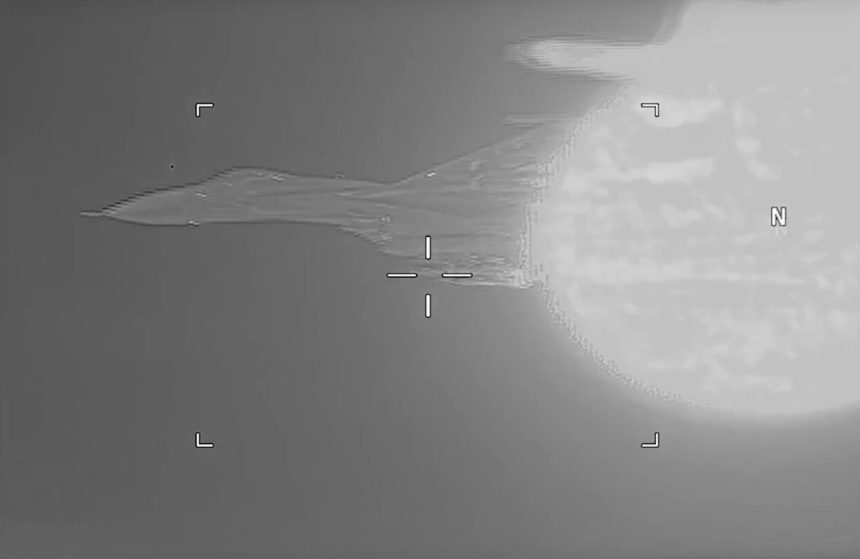Another “ordinary day” of Cold War over the Black Sea.
A U.S. EP-3E Aries aircraft flying in international airspace over the Black Sea was intercepted by a Russian SU-27 on Nov. 5, 2018.
According to the U.S. Navy 6th Fleet, “this interaction was determined to be unsafe due to the SU-27 conducting a high speed pass directly in front of the mission aircraft, which put our pilots and crew at risk. The intercepting SU-27 made an additional pass, closing with the EP-3 and applying its afterburner while conducting a banking turn away. The crew of the EP-3 reported turbulence following the first interaction, and vibrations from the second. The duration of the intercept was approximately 25 minutes.”
“While the Russian military is within its right to exercise within international airspace, this interaction was irresponsible. We expect them to behave within international standards set to ensure safety and to prevent incidents, including the 1972 Agreement for the Prevention of Incidents On and Over the High Seas (INCSEA). Unsafe actions increase the risk of miscalculation and potential for midair collisions.
The U.S. aircraft was operating in accordance with international law and did not provoke this Russian activity.”
Here’s the video. It’s not clear whether this is the closest one of the EP-3 intelligence gathering plane.
This is not the first time such close encounters occur. Another similar one happened at the beginning of the year, on Jan. 29, 2018, when a U.S. EP-3 Aries aircraft flying in international airspace was intercepted by a Russian Su-27 over the Black Sea.
Here’s what we wrote back then about these alleged unprofessional intercept maneuvers performed by Russian or Chinese fighters on U.S. spyplanes. It’s useful as it recalls the previous interactions all around the world.
This is not the first time a Chinese or Russian fighter pilot performs a Top Gun-like stunt or aggressively maneuvers close to a U.S. aircraft.
In February 2017, a People’s Liberation Army Air Force KJ-200 and a U.S. Navy P-3 Orion aircraft were involved in what was defined by U.S. officials as an “unsafe” close encounter over the South China Sea.
Last year, on Apr. 29, 2016, a Russian Su-27 Flanker barrel rolled over the top of a U.S. Air Force RC-135 aircraft operating in the Baltic Sea. The Russian jet came within 25 feet of the U.S. intelligence gathering aircraft.
Another Su-27 had carried out the same dangerous maneuver on another US Rivet Joint over the Baltic on Apr. 14, 2016.
Previously, on Jan. 25, 2016 another U.S. RC-135 intelligence gathering jet was intercepted over the Black Sea by a Russian Su-27 Flanker that made an aggressive turn that disturbed the controllability of the RC-135.
On Apr. 7, 2015 another Su-27 flew within 20 feet of an RC-135U over the Baltic Sea.
On Apr. 23, 2015 a U.S. Air Force RC-135U Combat Sent performing a routine surveillance mission in international airspace over the Sea of Okhotsk, north of Japan, some 60 miles off eastern Russia was intercepted by a Russian Su-27 Flanker that crossed the route of the U.S. aircraft putting itself within 100 feet of the Combat Sent.
In 2014, a Chinese Flanker made a barrel roll over a U.S. Navy P-8 maritime surveillance plane 135 miles east of Hainan Island, a spot where a dangerous close encounter of another U.S. electronic surveillance plane with the Chinese Navy took place back in 2001: on Apr. 1, 2001, a U.S. Navy EP-3E with the VQ-1, flying an ELINT (Electronic Intelligence) mission in international airspace 64 miles southeast of the island of Hainan was intercepted by two PLAN (People’s Liberation Army Navy) J-8 fighters. One of the J-8s piloted by Lt. Cdr. Wang Wei, made two close passes to the EP-3 before colliding with the spyplane on the third pass. As a consequence, the J-8 broke into two pieces and crashed into the sea causing the death of the pilot, whereas the EP-3, severely damaged, performed an unauthorized landing at China’s Lingshui airfield.
The 24 crew members (21 men and three women), that destroyed all (or at least most of ) the sensitive items and data on board the aircraft, were detained by Chinese authorities until Apr. 11.









